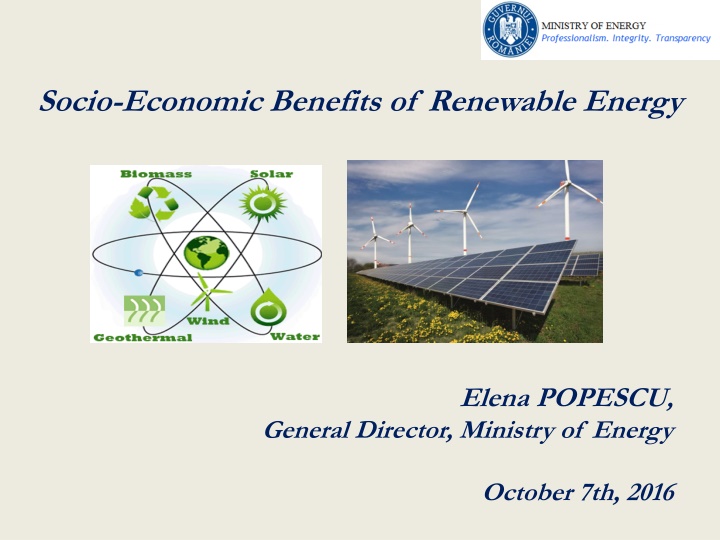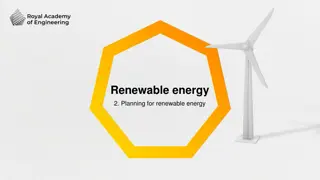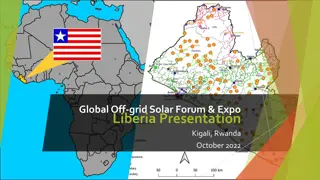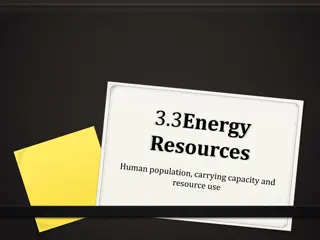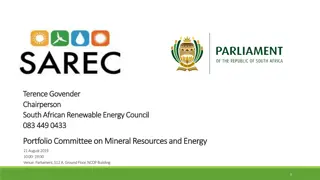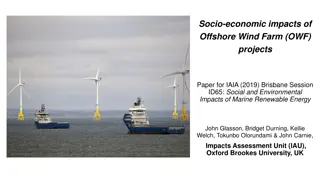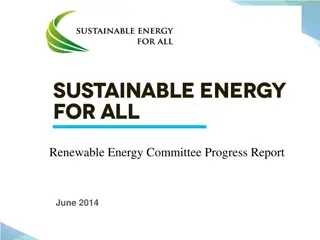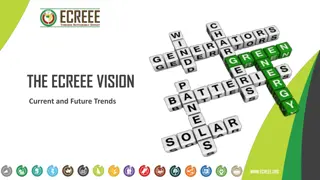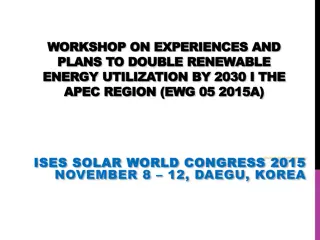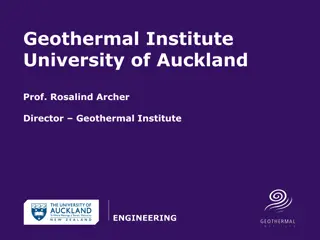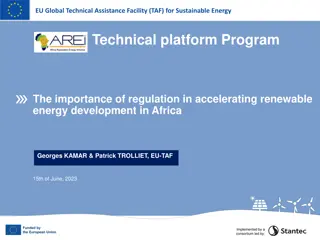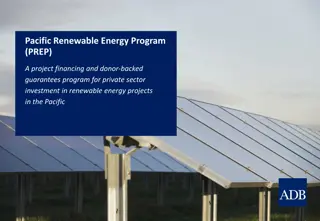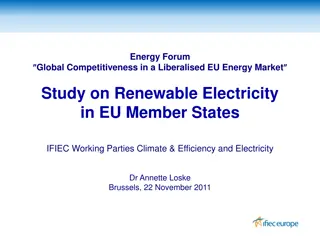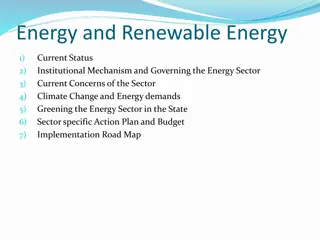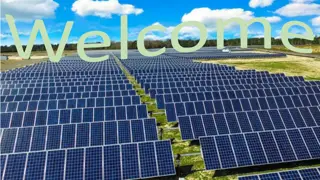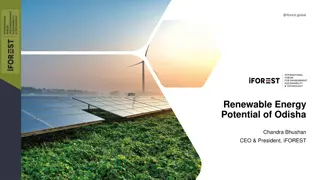Maximizing Socio-Economic Benefits of Renewable Energy
In a European and international context, the focus is on transitioning to low-carbon societies with renewable energy technologies. Challenges in current market designs are addressed, emphasizing the importance of long-term investment incentives and fair cost allocation. The distribution of gross production in 2015 highlights the pivotal role of hydro, wind, solar, and nuclear power. The goal is to ensure energy security in Romania with minimal costs, promoting a technology-neutral approach that minimizes carbon footprints and internalizes externalities.
Uploaded on Mar 11, 2025 | 0 Views
Download Presentation

Please find below an Image/Link to download the presentation.
The content on the website is provided AS IS for your information and personal use only. It may not be sold, licensed, or shared on other websites without obtaining consent from the author.If you encounter any issues during the download, it is possible that the publisher has removed the file from their server.
You are allowed to download the files provided on this website for personal or commercial use, subject to the condition that they are used lawfully. All files are the property of their respective owners.
The content on the website is provided AS IS for your information and personal use only. It may not be sold, licensed, or shared on other websites without obtaining consent from the author.
E N D
Presentation Transcript
Socio-Economic Benefits of Renewable Energy Elena POPESCU, General Director, Ministry of Energy October 7th, 2016
European and international context Paris Climate Agreement limit global warming to below 2 C The way forward: 2030 Energy and Climate Change targets The Energy Union 40% cuts in greenhouse gas emissions Energy security, solidarity and trust Low-carbon technologies which include large hydro, nuclear and renewable (including wind, solar, geothermal, and other zero-emission sources of power) A fully integrated internal energy market EU level target of at least 27% of renewable energy Energy efficiency Transition to a long- lasting low-carbon society New renewable energy technologies which include only wind, solar, geothermal, and other zero emission power sources 27% improvement in Energy Efficiency An Energy Union for Research, Innovation and Competiveness
Challenges of current market designs The Current Situation Current electricity markets do appropriate long-term investment incentives for technologies such as: Hydro Wind Solar Nuclear Forcing low-carbon investments in such markets would require very high CO2 prices and could entail serious risks to the security of electricity supply The way forward wholesale provide not the Ensuring electricity requires new arrangements for appropriate long-term investment signals as well as a robust CO2 price low-carbon investment in low carbon Different technologies will play different roles Nuclear and hydro, for instance, are dispatchable Wind and solar are not dispatchable The system effects of each technology need to be appropriately taken into account and costs fairly allocated
The structure of the gross production (2015) [ Total production: 65598 GWh ] Solar 2003; 3,05% Nuclear 11638; 17,74% Biomass 529; 0,81% Wind 7062; 10,77% Coal 18345; 27,97% Hydro 16622; 25,34% Hydrocarbons 9399; 14,33%
The strengths promoted Ensure energy security of Romania for a minimum cost A neutral approach from the point of view of technology with reduced carbon footprint and internalize externalities in the cost of producing electricity for all energy technologies; Choosing the optimal energy mix based on existing resources Hydro Coal Natural gas Uranium Increase the share of renewable energy, together with grid reinforcement and smart grid development Decarbonisation in the production sector but at an affordble cost The choice of technologies that bring added value to economic growth and employment Maintaining economic competitiveness
The available installed capacities 2010-2014 wind Puterile instalate si disponibile intre anii 2010-2014 EOLIAN Pi,Pd [MW] 2800.000 2600.000 2400.000 2200.000 2000.000 1800.000 1600.000 1400.000 1200.000 1000.000 Pi 800.000 600.000 400.000 200.000 0.000 01.01.2010 20.10.2010 01.01.2011 10.03.2011 01.06.2011 01.08.2011 01.11.2011 01.01.2012 01.06.2012 07.09.2012 24.10.2012 07.12.2012 01.01.2013 01.04.2013 01.07.2013 01.10.2013 01.12.2013 01.01.2014 01.03.2014 01.04.2014
The available installed capacities 2010-2014 solar Puterile instalate si disponibile intre anii 2010-2014 FOTOVOLTAIC Pi,Pd [MW] 1200 1150 1100 1050 1000 950 900 850 800 750 700 650 600 550 500 450 400 Pi 350 300 250 200 150 100 50 0 01.01.2010 20.10.2010 01.01.2011 10.03.2011 01.06.2011 01.08.2011 01.11.2011 01.01.2012 01.06.2012 07.09.2012 24.10.2012 07.12.2012 01.01.2013 01.04.2013 01.07.2013 01.10.2013 01.12.2013 01.01.2014 01.03.2014 01.04.2014
RES development priority versus challenges At the end of 2011, Romania has exceeded its first interim national target set for 2011 and 2012 - 19% of energy from renewable sources in gross final consumption of energy, achieving a level of 23.6% This level is almost equal to the national target assumed by Romania and established through Directive 2009/28/EC for 2020 24% Challenges: - Development of RES much quicker than anticipated overgenerous initial grant of GCs - Higher cost to consumers - Various measures taken to mitigate effect but these often applied to existing projects - Not enough money in the system: - Either generators lose out on funding - Or consumers lose out in higher prices - Problem is therefore about sharing the shortfall : between producers/consumers
Profitability of producers versus Affordability for consumers - Wholesale price is significant element in GC investment profitability - introduce an uncertainty in the investment model - Higher wholesale price = better RES return but negative result on consumer affordability regardless of GC cost - Increase quota of RES = increase cost Affordability determined by: - Consumer income - Cost of other elements of electricity price (wholesale price, tax, etc.) Affordability affects: - Average consumer - Poorest consumer - Industrial competitiveness Regulatory changes already made: adaptation or replacement? Real issue:
Clean energy has a cost - bridging the gap between costs and benefits Energy production typically results in direct and indirect costs to the producer and to the society: Cost structure: - Social costs - Private costs Main components: - Pollution (e.g. air and water pollution) - Operating costs (fuel) - Investment costs Main components: - Environmental benefits, improved standard of living - Revenue from selling energy Benefit: - Social benefit - Private benefit
Positive Overall Economic Effects Reduction of fossil energy import - Less dependency upon foreign energy supply - Less price volatility - Energy security Improvement of electrical energy supply, especially for rural areas; Remote regions without grid access: - Improvements of standard of living and chances for business opportunities through supply of electricity Costs savings in new grid and high voltage transmission lines investments
Address sensitivities of SEE - - SEE specificities: vulnerabilities, economic gap with NW Europe Evaluate real potential for development of RES; Analyse the whole electricity system and infrastructure and develop in coordination with the enforcement of the grid security of grid; Take into consideration affordability of the consumer; a very ambitious target for a low economic developed country could result into failure of the whole energy system; Take into consideration the transition towards the high RES quota when it is steel need for fosil sources; we can not afford to eliminate coal and nuclear (for countries reling on nuclear) until full deploiment of efficient, afordable, reliable RES and electricity storage; Give clear signal to investors; there is a need for investment in all areas of energy system; single RES can not solve our energy needs; Consider the economic stability on implementing the specific legislation : base legislation on independent impact studies; Technology transfer. - - - - -
Elena POPESCU, General Director, Ministry of Energy Contact: E-mail: elena.popescu@energie.gov.ro Tel: +4021 4079932 Address: Splaiul Independentei, 202E, Bucharest, Romania www.energie.gov.ro
